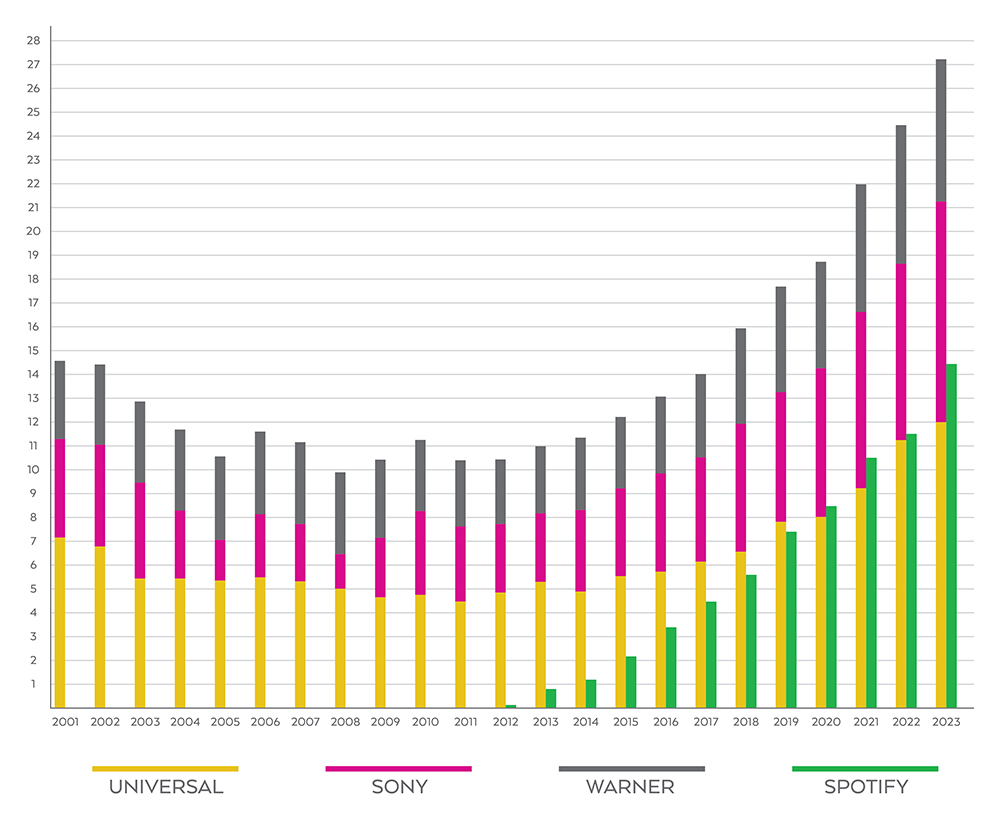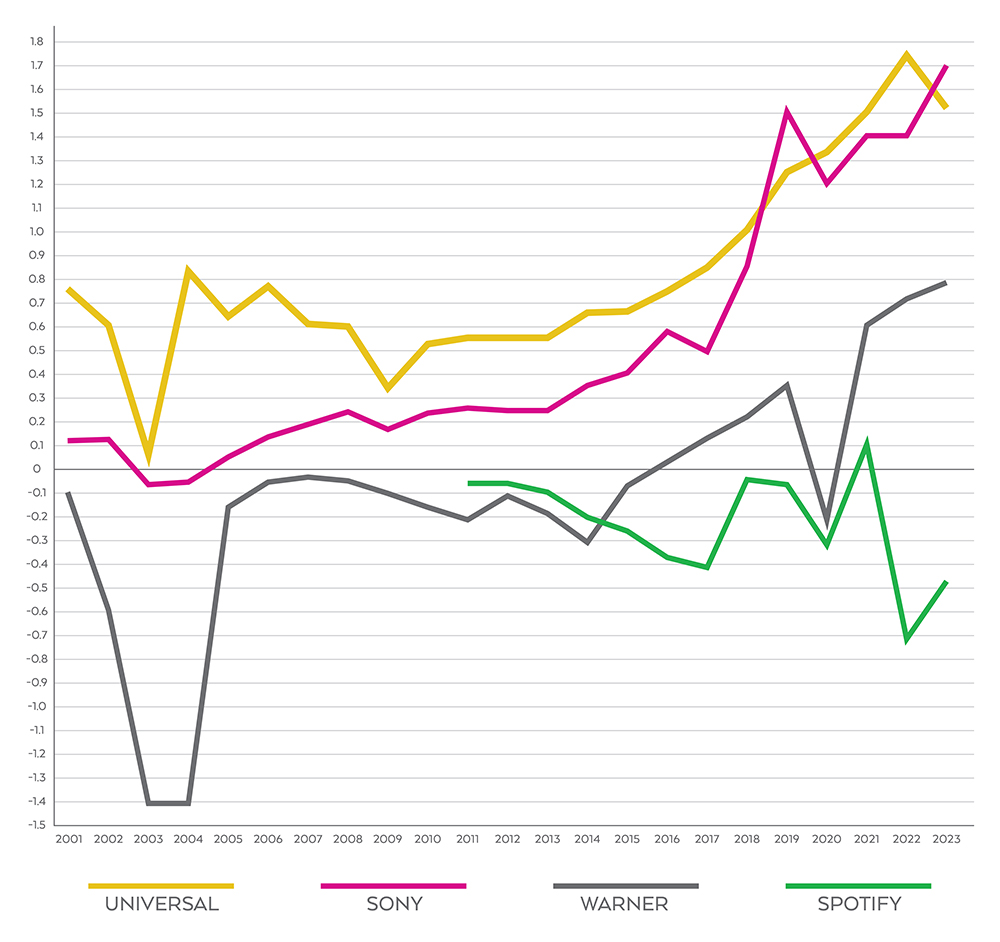CAN SPOTIFY SAVE ITSELF?
The music industry continually views the year 1999 as both its crowning achievement and the beginning of the end. That year saw peak sales of compact discs, the first digital form of music, totaling $14.6 billion. That same year, Napster was launched, allowing free digital music downloads until it was sued out of existence in 2001. But the damage had been done, and the music industry found itself in a downward spiral of continually diminishing revenues. But in 2011, a solution appeared that promised to reverse this trend. That year, Spotify launched its application in the United States, and by 2014, music revenues were growing more than 6% every year. This is how Spotify saved the music industry.
The first legal solution to music piracy that involved all the major record labels was Apple's iTunes Store, launched in 2003. It was a uniquely revolutionary concept. After decades of albums being the only way to purchase songs, customers now had a true, "a la carte" option to purchase just the songs they wanted. By 2010, iTunes was the largest music retailer in the world, and offered over 12 million songs. But the revenues of music labels kept declining.
The advent of digital file sharing perfectly coincided with the decline of music industry revenues. The explanation and argument seemed obvious: music piracy was resulting in lower revenues for artists and producers, and also weakened copyright protection which would eventually reduce the amount of new music being created. That mantra has been repeated in hundreds of articles for decades, despite the fact that very little data analysis has been done to support the charge. In fact, a few papers have demonstrated that piracy has a statistically zero effect on sales, and does not limit the production of new music. The music industry itself has revealed that the production of music has exploded since the digital revolution. A less promoted, but more logical, explanation is that the majority of music consumers have never purchased music. Radio led to file sharing which led to streaming, and those vehicles are just more appealing to most people. Compact disc sales plummeted not because people preferred to steal music, but because people preferred to not own music. Streaming just makes more sense to more people, especially if it affords access to all the music in the world.
Enter Spotify in 2006. The Swedish company developed a solution to deliver any song, anywhere, on demand. When Spotify entered the US market in 2011, it took a page from Apple and struck a deal with every major music label. At the time, Universal Music Group, Sony Music Entertainment, and Warner Music Group (the Big Three) controlled 10% of all published music, but 70% of all music revenue worldwide. In order to provide the largest possible catalog of music, Spotify offered the Big Three a combined 18% of its revenues, plus 70% of all royalty payments. The music labels agreed, and 2011 became the year that changed everything for them.
ANNUAL REVENUE IN BILLIONS OF US DOLLARS

ANNUAL PROFIT IN BILLIONS OF US DOLLARS

The deal provided Spotify with the content to grow its business into the largest music streaming app on the planet. But the deal has also proven to cripple the company's ability to generate profits. In 2016, streaming surpassed music purchases, accounting for $2.4 billion and more than 34% of music revenue. That revenue was shared primarily between Sirius XM and Spotify. The difference is that Sirius XM made over $3 billion that year, while Spotify lost over $300 million. Last year, Spotify posted gross revenues of $14.3 billion, nearly the same amount as the entire music industry made in its glory year of 1999. The Big Three grossed a combined $27.2 billion, and generated $4 billion in profit. Spotify lost $482 million.
Spotify currently accounts for over 30% of all streaming music revenue, more than twice that of the next two players, Apple and Amazon. But so much of its revenue goes to royalty payments that Spotify has only posted a profit in one of its eighteen years of existence. It looks like that trend might change in 2024. Citing company layoffs, increased subscription prices, creative monetization of podcasts, and expanding markets, Spotify appears poised to post a significant profit this year for the first time. Time will tell, but for now, Spotify has proven extremely valuable for music labels and music lovers. It may have even saved the music industry. The question now is: can Spotify save itself?
SOURCES
- "2021 Was the US Record Industry's Biggest Ever Year" from Music Business Worldwide
- "iTunes Store Tops 10 Billion Songs Sold" from Apple
- "The Effect of File Sharing on Record Sales: An Empirical Analysis" from Journal of Political Economy
- "Music Piracy and Its Effects on Demand, Supply, and Welfare" from Innovation Policy and the Economy
- "Music Streaming Hits Major Milestone as 100,000 Songs are Uploaded Daily to Spotify and Other DSPs" from Variety
- "The Economics of Spotify" from the Hustle
- "Apple's iTunes Overtaken by Streaming Music Services in Sales" from Bloomberg
- "The Three Major Music Publishers Now Own or Control Over 10 Million Songs Between Them" from Music Business Worldwide
- "A 'Complete Reset' of the Music Industry?" from the Oxford Society for Commercial Law
- "Spotify Saved the Music Industry. Now What?" from Fortune
- "Spotify Turns Up Volume to Make Record Profits" from BBC
- Revenue and earnings data from various annual reports













